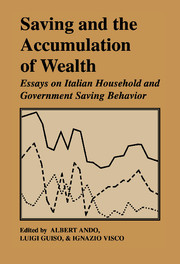Book contents
- Frontmatter
- Contents
- Foreword by Antonio Fazio
- List of contributors
- List of figures
- List of tables
- Acknowledgments
- Introduction
- I Saving trends, government deficit and demographic changes
- II Life-cycle saving and precautionary motives
- 5 Young households' saving and the life cycle of opportunities. Evidence from Japan and Italy
- 6 Dissaving by the elderly, transfer motives and liquidity constraints
- 7 Earnings uncertainty and precautionary saving
- 8 Risk sharing and precautionary saving
- III Borrowing constraints, intergenerational transfers and bequests
- Appendixes
- Index
5 - Young households' saving and the life cycle of opportunities. Evidence from Japan and Italy
Published online by Cambridge University Press: 05 May 2010
- Frontmatter
- Contents
- Foreword by Antonio Fazio
- List of contributors
- List of figures
- List of tables
- Acknowledgments
- Introduction
- I Saving trends, government deficit and demographic changes
- II Life-cycle saving and precautionary motives
- 5 Young households' saving and the life cycle of opportunities. Evidence from Japan and Italy
- 6 Dissaving by the elderly, transfer motives and liquidity constraints
- 7 Earnings uncertainty and precautionary saving
- 8 Risk sharing and precautionary saving
- III Borrowing constraints, intergenerational transfers and bequests
- Appendixes
- Index
Summary
Introduction
The earnings profile appears to rise steeply with age in most countries, especially those with rapid growth such as Italy and Japan. It is therefore natural to expect that, because of the consumption smoothing principle, young people will dissave.
Using microdata for Japan and Italy, we show that families and singles both save and accumulate net worth throughout their working lives, even while they are quite young and their current incomes are lower than future incomes.
We are thus faced with the question as to why young people do not dissave. This is a shift in emphasis from recent literature, in which much effort has been devoted to devising modifications to the life–cycle theory that could accommodate the relatively low propensity to dissave by older, retired families.
The mere lack of dissaving by very young households may be explained by the presence of liquidity constraints or myopia. The ingenious interaction of liquidity constraints with uncertainty recently proposed by Deaton (1991) can, within a buffer stock context, explain a limited amount of saving; it is, nonetheless, probably inadequate to explain the significant saving by very young households with relatively low incomes.
We propose instead an explanation based on the hypothesis that, for very young households, due to the expectation of (future) consumption opportunities not available today, higher future income might be accompanied by larger needs.
- Type
- Chapter
- Information
- Saving and the Accumulation of WealthEssays on Italian Household and Government Saving Behavior, pp. 163 - 187Publisher: Cambridge University PressPrint publication year: 1994
- 2
- Cited by

